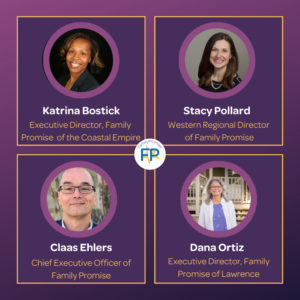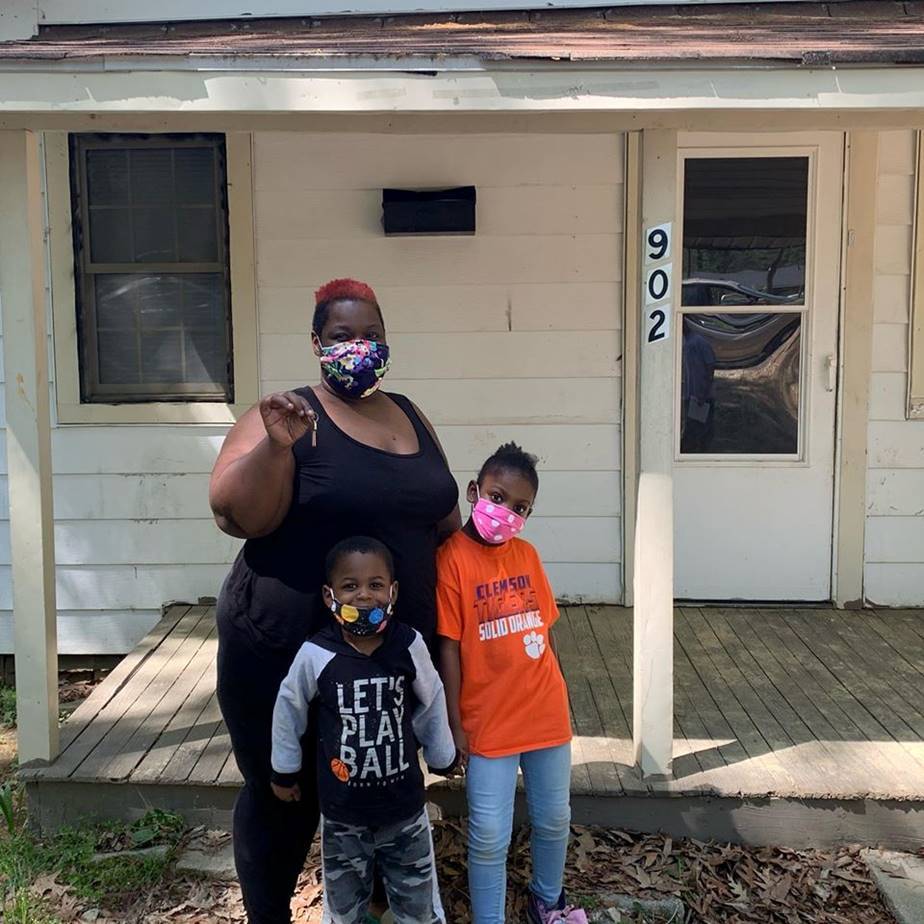Family Promise leaders praise new legislation, child tax credit, and rent relief; fear end of eviction moratorium will lead to eviction of families with children.
Summit, NJ – On Friday, March 12, four family homelessness experts spoke about the expected impacts of the American Rescue Plan for families experiencing homelessness in a press conference hosted by Family Promise, the nation’s leading nonprofit addressing family homelessness.
 Claas Ehlers, CEO of Family Promise, Stacy Pollard, Western Regional Director of Family Promise, Katrina Bostick, Executive Director of Family Promise of the Coastal Empire (GA), and Dana Ortiz, Executive Director of Family Promise of Lawrence (KS) praised provisions included in the American Rescue Plan like funding for rent relief and the child tax credit as important steps towards mitigating child poverty across America.
Claas Ehlers, CEO of Family Promise, Stacy Pollard, Western Regional Director of Family Promise, Katrina Bostick, Executive Director of Family Promise of the Coastal Empire (GA), and Dana Ortiz, Executive Director of Family Promise of Lawrence (KS) praised provisions included in the American Rescue Plan like funding for rent relief and the child tax credit as important steps towards mitigating child poverty across America.
“The American Rescue Plan that just passed is, in my opinion, really incredible legislation. It’s attacking child poverty, which is at the core of our work,” said Ehlers. But Ehlers said it is too soon to know what the impacts of this legislation will be and how it will be implemented. He also cautioned that the legislation fails to address the end of the federal eviction moratorium, which is scheduled for the end of March.
The American Rescue Plan includes $27 billion in rental assistance, $5 billion in emergency housing vouchers, $5 billion in homelessness funding, and $800 million to support schools for education enrollment and supports.
While this support will go a long way, a recent study by the U.S. Census Bureau found that one in six families across the nation is currently behind on their rent payments.
“We are thrilled to be able to access those resources for our families, but out of that we do have some continuing concerns and challenges that we’re facing,” Pollard said. “Our Affiliate directors universally agree that they are afraid of what is going to happen when we lift the eviction moratorium.”
Ehlers, Pollard, Bostick, and Ortiz also outlined 5 underlying issues that they believe need to be addressed to protect low-income families.
Many families who have not needed social services in the past are seeking assistance due to the economic impacts of COVID-19.
“Prior to the pandemic, we were primarily seeing families experiencing longer-term poverty or generational poverty [seeking help]. Now we are also seeing families that have lost their income or lost their home because of something specifically COVID related, and this is all brand new for them,” Pollard said.
Finding housing for families in shelters is increasingly difficult, leading to longer shelter stays.
Before the COVID-19 pandemic, at Family Promise Affiliates across the western U.S., shelter stays averaged approximately 9 weeks. Now many families are staying in shelter for an average of five to seven months, Pollard said.
While the eviction moratorium protects leaseholders from losing housing, it does not protect those who are in living arrangements without a formal lease.
One example of this is those who are staying with family members and not listed on the lease.
“This is really adversely affecting multi-generational households. Only the people listed on the lease are protected by the eviction moratorium, so landlords are starting to find family members outside of that lease and forcing those family members to leave,” Pollard said. “This is very much affecting younger single mothers that may have had to move in with their family members for support for their children. These are the families being evicted.”
Many landlords are experiencing economic distress and low-income housing is becoming harder to find as many people move from urban centers into formerly low-income neighborhoods.
Ehlers said he is concerned that without support for smaller landlords currently losing rental income a large quantity of low-income housing may be lost when these landlords are forced to sell their properties, putting both the families of renters and landlords at economic risk.
“Smart policy, whether it is housing policy, economic policy, or health policy, is don’t let families experience homelessness,” Ehlers said.
With many school districts still doing virtual learning, there is less of an understanding of how many families are experiencing homelessness or need services.
The McKinney-Vento Homeless Assistance Act required schools to count and provide support to families experiencing homelessness, but without consistent in-person school, it is estimated that in the first quarter of the 2020-2021 school year alone, students experiencing homelessness were undercounted by approximately 420,000.
“That is a huge loss that our children are no longer able to access those school supports,” Pollard said. “Our shelters are feeling more weight and pressure to fill in some of those gaps.”
Additionally, Family Promise Affiliates are seeing more children struggling with mental health issues.
“West Coast schools have been primarily virtual since the pandemic hit and that’s caused, universally, outside of homelessness, a lot of isolation for our children. When you layer homelessness on top of that, there is difficulty participating in virtual school,” Pollard said. “If you are a family experiencing homelessness, you may not have access to the internet, electricity, or a working computer. So that deepens the isolation our children are experiencing, and they are also experiencing the stress of not having a home.”
Some Family Promise Affiliates have also seen increased rates of suicide attempts in their communities for children under eighteen.
Case Study: Family Promise of Lawrence, KS
Family Promise of Lawrence, KS is in a community whose primary industry is hospitality. Hotels, restaurants, and other amenities thrive on business from students at the University of Kansas and Haskell Indian Nations University and their families.
“When COVID hit, that hit our community incredibly hard,” Ortiz said. “Those businesses were hit tremendously hard, as well as, of course, their employees.”
As soon as COVID-19 lockdowns began closing businesses in the community, Family Promise of Lawrence saw an increase in the number of calls from families needing assistance.
These calls came “from folks who hadn’t sought services before but were living pretty much paycheck to paycheck. And then the paychecks stopped,” Ortiz said.
Even before the pandemic, a study conducted by a consulting firm showed that there were not nearly enough affordable housing units in Lawrence. Over 5,000 households were over-burdened by the cost of housing and families with children were found to be more likely to experience housing displacement.
Family Promise of Lawrence addressed the increased need for support by growing their homelessness prevention program. The Affiliate, along with a cohort of other community organizations, was able to distribute just under $1 million in rental assistance in the last quarter of 2020.
“This pandemic has shown so critically the importance of housing,” Ortiz said. “It’s not just human dignity, a right, and respect, but it’s healthcare.”
Case Study: Family Promise of the Coastal Empire, Savannah, GA
Family Promise of the Coastal Empire serves three counties in Georgia: Chatham County, Bryant County, and North Effingham County, which cover a variety of communities, including both urban and suburban areas.
The Family Promise Affiliate was previously three separate organizations that merged during the pandemic to better coordinate a local response to family homelessness.
Like Family Promise of Lawrence, Family Promise of the Coastal Empire saw an immediate increase in calls from families seeking help for the first time at the start of the pandemic.
“We had to really plan for this huge increase and huge influx of families who were impacted by COVID,” Bostick said.
The Affiliate already had a robust homelessness prevention program, but quickly mobilized to expand this program and launched a partnership with the local United Way.
Bostick said that, despite the eviction moratorium, families in the region are still being evicted from their homes in select circumstances.
“With the eviction moratorium, what we are seeing is families being evicted, not for non-payment, but just for violations, which the eviction moratorium does not cover,” Bostick said. “So, for those families that may have additional family that has had to move in with them and they are not on the lease, landlords are taking that opportunity to file evictions on them. Landlords are looking at other ways that they can kind of get around the moratorium to evict households.”
The full recording of the press conference is available here.
About Family Promise
Family Promise envisions a nation in which every family has a home, a livelihood, and the chance to build a better future. What began as a local initiative in Summit, NJ, has become a national movement that involves 200,000 volunteers and served more than 111,000 family members in 2019. Family Promise will change the future for 1 million children by 2030.
Currently, Family Promise is working in over 200 communities in 43 states to ensure that families experiencing homelessness have a safe place to call home and the resources they need during the COVID-19 pandemic. For more information about our emergency response efforts, visit FamilyPromise.org.

